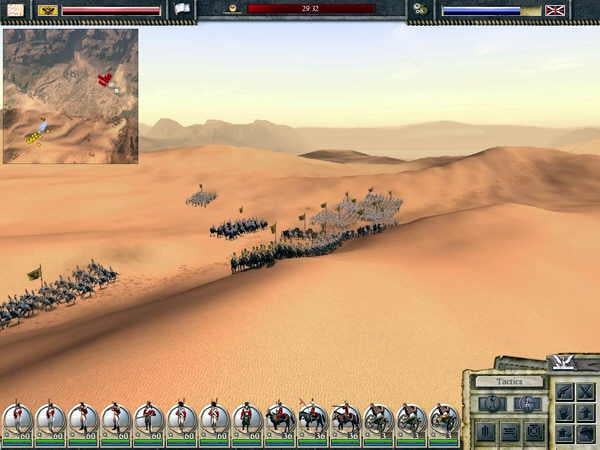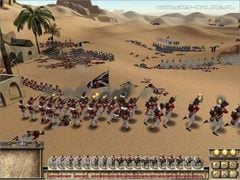


Unfortunately, the company wasn't demonstrating the naval battles yet - though the press materials included with the title indicate that, like garrisoned buildings, ships will be crewed by individual sailors. Based on the few battles I was able to see, it seems as if Pyro has really done it's homework, accurately reproducing the square marching formations and colorful clothing of the era - everything from tassels on swords to the black furry hats of charging Russians. Real history buffs will be thrilled by the historically accurate units and weaponry. According to Pyro, the ability to garrison units will be a big part of the strategic challenge of Imperial Glory. To my amazement, the beautifully animated individual soldiers did so - not by disappearing and changing the building art, but by actually running into the structure and taking up defensive positions! Every single unit on the field was individually animated, some crouching behind fallen pillars, other taking up positions on the roof. The first thing the Pyro demonstrator did was give order to garrison the building. I noted it and immediately dismissed it, assuming it was merely a graphic embellishment of no possible strategic significance. Just to the east of several of the French units was an ancient Greek ruin - all white marble and fallen columns. The first battle I saw took place on the poplar-studded hills of Greece. The first thing that leaps out at you when one of the battles begins is the beauty of the game's engine. The heart of the game, though, resides in the real-time strategy battles the game descends to when combat begins. In order to build up your territories, you can construct buildings that either increase your resources or allow you to build army units. The game also allows players to marshal the resources of controlled territories to build armies, invest in scientific research or build up wealth that can be used in the game's extremely robust diplomatic screen to make alliances, negotiate movement treaties or bribe others to attack your enemies.

Imperial War players can take on the roles of England, France, Prussia, Austria-Hungary The turn-based section of the game includes unit markers the represent various armies and other units that can be moved around the European theater. The game's timeframe isn't definitively set, but seems to progress from the 1780's to approximately 1890, the age of great set-piece armies and Imperial ambitions that resulted in several great empires constantly jockeying for position. Imperial Glory is divided up into two major sections, a turn based strategic game played out on a flat map of Europe and a real-time strategy game that includes land-based and naval combat. The logo above the station said Imperial Glory, and it looks like it might be shaping up as developer Pyro Studios' answer to the Total War series. I had come to see some other stuff, but then I noticed a tiny little strategy buried in a back corner of the private showing room. For me, that happened on the first day during a visit to the Eidos booth. You're wandering through the halls of E3 looking at things that have been hyped up the wazoo and you inevitably come across a game buried in a back corner of a booth that really deserves more attention than it's probably going to get.


 0 kommentar(er)
0 kommentar(er)
